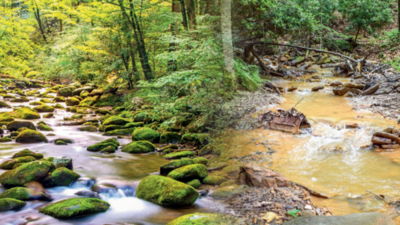- News
- India News
- Times Evoke News
- ‘Corporations claim it’s always jobs vs nature — but workers in the US forged movements to protect both’
Trending
‘Corporations claim it’s always jobs vs nature — but workers in the US forged movements to protect both’
Chad Montrie, a history professor, highlights the labor roots of environmentalism in the US, explaining how ecological consciousness and activism among workers began in the early 19th century. He critiques the narrative that modern environmental movements started with Rachel Carson’s book 'Silent Spring' and showcases historical instances where workers prioritized both ecological preservation and their well-being.
Chad Montrie is professor of history at the University of Massachusetts, Lowell. He tells Srijana Mitra Das at TE about the working-class roots of environmentalism:
You can see a clear grey sky enfolding the room where Chad Montrie speaks with precision. ‘I was trained as a labour and an environmental historian. My research explores how the two fields overlap. I’m interested in how people develop an environmental consciousness and engage in ecological activism — I locate how workers were involved in the origins of environmentalism over two centuries in America.’
We often think of environmental movements as modern street protests outside bemused cafes or activists chaining themselves to artworks. However, Montrie finds this has much older roots. He explains, ‘Environmental consciousness began among workers in the US in the early 19th century. As industrial mass production came into being, workers experienced its environmental hazards — textile mills came up in places like Lowell, Massachusetts, which built dams to control water. Meadows which gave cattle grass were flooded while fish which sustained many were poisoned as the mills released toxic chemicals into canals — these were also receiving raw sewage from growing cities meanwhile. Cholera spread among workers and they protested, seeing how ecological degradation was damaging their own well-being.’

Montrie dispels more myths. ‘The classical perception about environmentalism starting in America hinges on Rachel Carson’s book ‘Silent Spring’ published in 1962. People feel this launched the ecological movement — I disagree. Thinking about environmental problems and starting movements for these goes back to the emerging industrial economy of the 19ᵗʰ century — the people at the centre of that history are working-class people while the ‘Silent Spring’ narrative focuses on middleclass white people in America’s suburbs.’

Carson’s book, an expose of pesticides, focused on what these chemicals meant for living things but, Montrie points out, ‘With a few exceptions, she completely ignored farm workers. That was ironic, given how such workers were most likely to be exposed to large doses of these chemicals on a regular basis. By the 1960s, 71% migrant farmworkers showed symptoms of chemical poisoning — they organised into the United Farm Workers union and bargained for better wages, hours — and controls on pesticide exposure. The first contract they got in the late 1960s gave them more protection than any state or federal legislation.’
There are further instances of workers starting environmental movements. After WWII, the coal industry shifted from underground to contour and surface mining. ‘This was advantageous to companies,’ Montrie comments dryly, ‘It was more efficient and needed fewer workers, part of a longer mechanisation history. But it was also more environmentally devastating — people in the coalfields of southern Appalachia started to experience both unemployment and severe pollution of water, deforestation, landslides, etc.’

Eventually, the United Mine Workers demanded an end to surface mining in the 1960s, their president, Arnold Miller, even testifying to Congress. Montrie says, ‘It seems astounding now that one of the leading voices trying to stop mining came from the coal workers’ union. They also used tactics similar to ecological activism of the 1990s — non-violent civil disobedience, blocking coal haul trucks, even sabotaging machinery. A collective in Kentucky was called the ‘Appalachian Group To Save The Land And People’, a name which tells you a lot.’ The workers nearly got Congress to stop mining in 1973 but with the interests involved, that didn’t happen. Activism then dipped as coal’s market declined.
JD Vance, America’s new Vice-President, hails from Appalachia — does he refer to this powerful labour history? Montrie laughs out loud. ‘Well, he isn’t exactly from Appalachia — he exaggerates that link, using this to seem more connected to common people. His grandparents lived there and he’d visit them. His book ‘Hillbilly Elegy’ speaks of the community but, in a nutshell, it blames people themselves for problems in this region, advising them to self-improve rather than have the government fix problems or blaming coal companies. For example, there is a lot of drug addiction in Appalachia — but Vance apparently doesn’t see this as linked to the coal industry eviscerating the region’s economy and ruining the landscape.’
How does Montrie analyse the Hobson’s choice people face in terms of keeping their employment versus damaging the environment? He says, ‘Corpo rations have promoted this idea that you must ‘choose’ between your job and the environment. That assumes these two are mutually exclusive. It also comes with a historical amnesia that claims workers always chose their jobs. However, my research across two centuries finds workers have chosen both. Neoliberalism in the 1980s-90s made this more difficult but there is a moment — a long moment — in history where hard-pressed workers collectivised and campaigned for both these protections in their lives.’

Get the latest lifestyle updates on Times of India, along with Navratri Wishes, Eid Messages and quotes !
End of Article
FOLLOW US ON SOCIAL MEDIA










